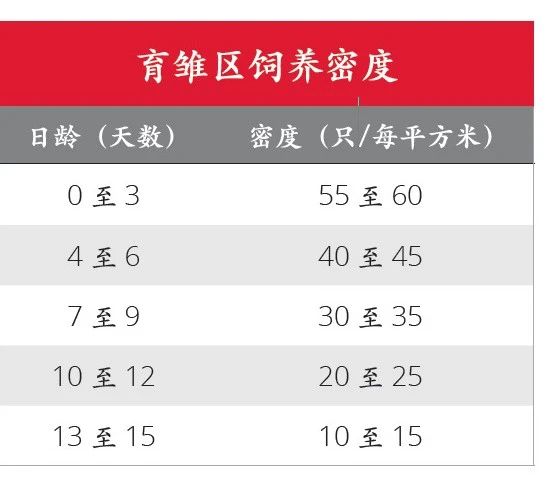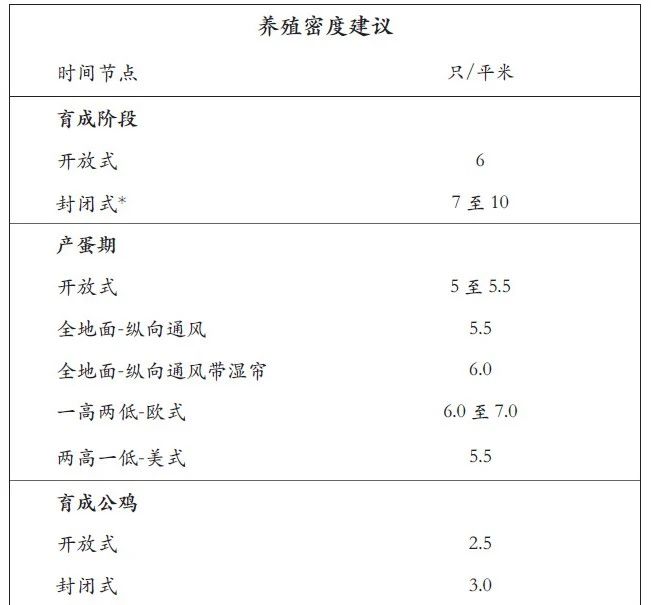The goal of designing and managing a broodroom is to expand the brooding area as soon as possible while maintaining the correct room temperature. Before expanding the brooding room area, unused areas should be heated and ventilated to the correct temperature for at least 24 hours. Generally speaking, the partition of the brooding house should be fully opened after 14-16 days, depending on the final density capacity and the structural conditions inside the house.
The density of brooding will depend on the size and equipment of the brooding area. The initial stocking amount should not exceed 55-60 feathers per square meter. Ensure sufficient drinking water space, especially during the summer chicken season - if nipples are easily activated, calculate at 40 feathers per nipple.

Animal Welfare Tips
If the use of brooding area insulation curtains is not allowed in the house, the entire house should be heated and ventilated to optimize the comfort and temperature requirements of the chicks. To keep the chicks in a smaller brooding area during the week, lighting and/or brooding compartments can be used. In terms of lighting, the lights in the chick rearing area should be on to encourage chicks to move around and eat and drink. The lights in other parts of the building should be kept off. Chickens rarely run to dark (unlit) areas inside the house, so they stay in the brooding area. If using brood barriers (paper, metal, or wire partitions), they should be placed carefully to prevent chicks from being pinched. Ideally, padding should be used to "seal" or completely cover the bottom of the brood enclosure, and stable partitions should be used to ensure that the partitions remain vertical.
Breeding density
After arriving at the chicken farm, chicks with similar maternal age should be placed in the same column (or shed). Keeping these chicken flocks together can improve the uniformity of the flock in the future.
During the breeding process, the correct feeding density is the key to ensuring excellent performance. In addition to performance and uniformity, the correct feeding density also has a significant impact on welfare. In order to accurately evaluate feeding density, factors such as climate, chicken coop type, ventilation system, processing, and welfare regulations must be considered.
It is important to remember that throughout the entire feeding and production process, the feeding density should be guided by the spatial requirements of the feeding and water lines. Material line space is an important spatial requirement, regardless of age. If the space requirements of the feed line are not met, the uniformity of the chicken flock will be affected, as chickens will only compete for available feed. Waterline space is equally important because chickens must drink water to digest their feed. After finishing the feed, there will be some competition for drinking water positions.

Roosters should be raised separately from hens during the transition from seedling feeding to herd or mixed breeding (approximately 20-23 weeks). This approach allows breeders to optimize the physical size, uniformity, and weight targets of male and female chickens. During the breeding process, roosters should be given more ground space to ensure they reach their target weight. Roosters of the same age tend to weigh significantly more than hens. Therefore, controlling weight is crucial for achieving uniform body development and synchronizing with the sexual maturity of hens.
Supplement water level
Many modern poultry houses are equipped with waterline systems, which can be used during chick rearing. Whenever possible, only use the main waterline system so that chicks can learn to use it as soon as possible.
If a water dispenser needs to be replenished, it is not recommended to use an open water tray as chicks may be immersed in it, and bedding and feed can also contaminate the water, resulting in poor water quality. The water dispenser should not be placed directly under the brooder, as this will cause the water to become hot and too hot to drink, while also increasing water evaporation.
Supplementary material level
The supplementary feeding equipment should not be placed directly below or too close to the heater, and the feed should be distributed well before the chicks arrive on site. Provide a supplementary feeding tray for every 75 chicks at one day of age, and ensure that the supplementary feed remains fresh. Remove the replenishment tray after the 7th day.
Another approach is to place a total of 30 grams of feed for each chicken on paper, covering 50% of the breeding area. This feed distribution should be consumed within the first 3 days. The paper used must be durable and not easily broken. We do not recommend using old news paper or other types of reusable paper as there are risks related to biosafety and material quality. After using up the feed, please remove the remaining paper.
Animal Welfare Tips
When expanding the fence, carefully observe the distribution and behavior of the chicks, as they have more space to move around. Chicks are naturally curious and want to explore, but they still need the correct temperature, lighting, and ventilation to ensure they are comfortable, active, and able to easily find feed and water in the expanded area. If supplementary water dispensers and/or feeding trays are used during the brooding period, they should be gradually removed from the brooding area in the days before the brooding room is fully opened. Shortly after the chicks arrive, pre fill the drip tray under the nipple with water to stimulate drinking.
Cushion material management
Cover the entire floor with new and fresh padding. It is important that the material of the padding provides a soft, dry surface to conduct radiant heat. Rake and press the cushion material flat. Uneven padding can cause uneven ground temperature, leading to flocks of chicks crowding together or lying under the heater. During this critical developmental period, uneven bedding can also lead to unexpected limitations in the acquisition of feed and water.
The height of the cushion material depends on the insulation condition of the ground and whether plastic moisture-proof measures are used below the cement floor? Summer or winter? Ventilation and feeding density. Try to use minimal padding to facilitate the control of padding and the level of padding height. Chicken manure will accumulate throughout the entire production process in the padding. The usual recommendation is to use 3-5 centimeters in summer conditions and 5-7 centimeters in winter.
Abundant Environment
Environmental richness is considered beneficial. Usually includes sensory stimulation, providing animals with choices in their environment. Items or devices may cause changes in behavior/activities related to social interaction (such as increasing or decreasing direct/indirect contact with other animals), habitual adaptation (such as encouraging movement or adapting to environmental challenges), physical adaptation, sensory stimulation (such as vision, hearing), or nutritional stimulation.
For poultry, the welfare related goals of adding energy enhancing devices in feeding and egg laying environments include: increasing behavioral diversity; Reduce the frequency of abnormal/negative behavior; Expand the scope of normal behavior; And enhance animals' ability to cope with challenges or changes. In addition, for poultry, goals related to the performance of breeding chicken flocks can include: improving the fusion of chicken flocks in the ground area; Reduce floor eggs; Improve foot and leg health; Reduce the mortality rate of breeding chicken flocks; Increase the total egg production of the breeding flock.
Enriching activities should not have adverse effects on the health and welfare of chicken flocks (i.e., items that may cause harm or pose a trapping threat should not be used), should not increase biosecurity risks, and should not have harmful economic impacts.
The typical environmental conditions that can be used in broiler chicken farms include: physical items (such as ramps, habitats, and platforms (sheds) or items that provide additional shelter (small sheds/tents)), nutritional and social stimuli to increase foraging or self-cleaning activities (such as bindings, pecking blocks, and feed distribution), and sensory stimuli (such as lighting or noise stimuli to train poultry). It should be noted that not all environmental conditions can be used simultaneously in breeding and production, therefore, careful planning and implementation should be carried out based on the age and variety of chickens. Equipment that can be used in both breeding and egg laying farms, such as sheds and shelters, to encourage chicken flocks to experience elevated equipment and different types of flooring, allowing them to quickly adapt to the production facility configuration of commonly used shed flooring and elevated shelters.
The chain feeding line in breeding should be highly managed to ensure that all chicken flocks can easily obtain feed, but at the same time, it is required that chickens can only jump and cross the track to improve their activity ability and activity level. The material line track with brackets can allow chickens to inhabit.
illumination
The intensity and distribution of light can alter the activity of chickens. It is necessary to stimulate the activity of chicks correctly with light during the first 5-7 days after birth to optimize feed consumption, digestive and immune system development, and good welfare. The light intensity should be based on 60-100 lux (6-10fc) under the lamp, and measured at the height of the chicks to increase their activity and encourage them to feed and water well in the early stages. Concentrating light around the waterline nipple can attract chicks and increase their early water and feed intake during the process of mutual learning.
When entering the chicken, it should be given 23 hours of light. At the age of 4 days, the light exposure time begins to decrease. Make sure to turn on the lights at the same time every day. When adjusting the lighting time, it is necessary to change the turn off time. By reducing the light intensity by 1 or 2 hours per day, the recommended 8-hour day duration will be achieved by the age of 14. We recommend continuing 8 hours of light exposure, with a light intensity of 2 to 4 lux, until the pre start light stimulation, depending on the light source.
The change in light intensity from bright to dark areas on the ground should not exceed 20%. Different light sources can cause significant variations in the light intensity at the height level of chickens. Uniform light distribution (>80%) during feeding will help maintain uniform bedding throughout the entire chicken coop, keeping the bedding at the same height as the chain or disc line. It is important for all hens to easily obtain feed at the same time. If there are dark or shaded areas in the breeding house, chickens will scratch the bedding from the bright areas to the dark areas. As a result, the uneven height of the material level along the material line track is caused, and the unevenness of the padding in the material level area will result in poor uniformity of the chicken flock.
During vaccination, weighing, and sorting, do not increase the light intensity. All maintenance work on the chicken coop should be carried out during the 8-hour light on period. Increasing or decreasing the intensity of light can reduce the sensitivity of chickens to light stimuli after 21 weeks of age. Excessive exposure to light during rearing (>10 hours) can delay the sexual development of chickens and should be avoided.







